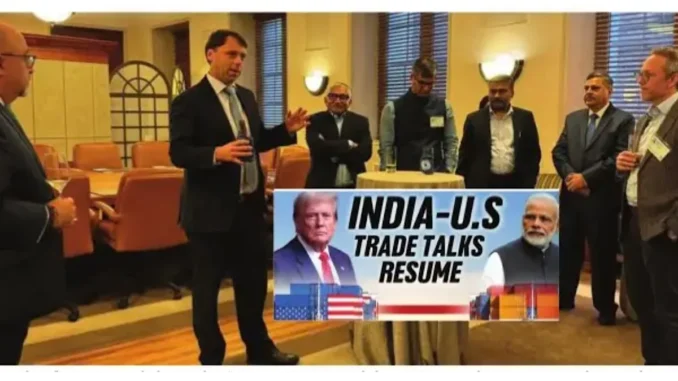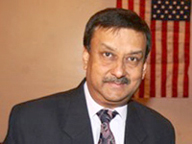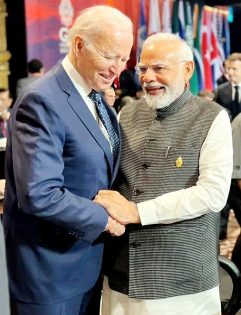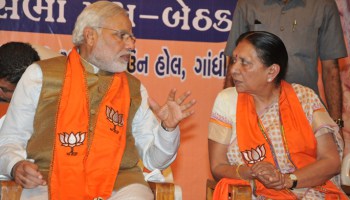

High-level trade talks between India and the United States resumed in New Delhi on 16 September 2025, after a recent thaw in tensions and positive public statements from both President Donald Trump and Prime Minister Narendra Modi. The latest round of discussion was led by the US delegation’s chief negotiator, Assistant U.S. Trade Representative Brendan Lynch, and his Indian counterpart, Special Secretary in the Department of Commerce Rajesh Agrawal. A key outcome of the “positive and forward-looking” meeting was the mutual agreement to “intensify efforts” toward an early conclusion of a trade agreement.
Relations strained considerably after President Trump imposed new 50 per cent tariffs on Indian exports in August 2025. This move was partly a penalty for India’s continued purchases of Russian oil amidst the Ukraine conflict. The tariffs significantly impacted trade, with Indian exports to the US falling from $8.01 billion in July to $6.86 billion in August. A breakthrough in the diplomatic stalemate occurred in September 2025 after President Trump posted optimistically about the ongoing negotiations on his social media platform, Truth Social. In response, Prime Minister Modi echoed the sentiment on X, expressing confidence in the bilateral trade discussions.
This exchange followed a period of hostile public comments from some US officials. Peter Navarro, a trade adviser in the Trump administration has made repeated critical comments about India, primarily regarding its trade relations with Russia and its high tariffs against the United States. Navarro called India the “Maharaja of Tariffs” and accused it of unfair trade practices. Navarro has also accused India of being an “oil money laundromat for the Kremlin” by importing cheap Russian oil, refining it, and then exporting fuel at a premium. He has repeatedly stated that India’s purchase of discounted Russian crude oil provides Moscow with funds for the war in Ukraine.
He has even referred to the conflict as “Modi’s war”. The Indian Ministry of External Affairs officially rejected Navarro’s statements. The MEA spokesperson called the comments “inaccurate and misleading” and stated that India’s focus remains on bilateral relations based on mutual respect and shared interests. India has defended its purchase of Russian crude oil, stating that its energy procurement is driven by national interests and market dynamics to keep energy prices stable. In early September 2025, Navarro sparked significant backlash for saying that “Brahmins” were “profiteering at the expense of the Indian people” from the Russian oil trade. The remark was widely condemned in India as casteist and culturally insensitive, drawing criticism from across the political spectrum. Some observers noted that Navarro may have been alluding to “Boston Brahmins,” a U.S. metaphor for entrenched elites.
However, the invocation of caste, even in this context, was met with strong condemnation in India. Recently, on September 13, U.S. Commerce Secretary Howard Lutnick was asked during an interview whether the US is mismanaging “very valuable relationships” with “important allies” like India, Canada and Brazil with the tariffs imposed on these countries. In response, he questioned why India, with its large population, refuses to buy American products, such as corn. He also said that it must reduce its tariffs or face business difficulties with the U.S. Thus, one should not think that the US has softened its position. Significant challenges persist, with India pushing for the removal of the 25 per cent oil-linked penalty tariff.
India has also repeatedly stated its reluctance to open up its protected agriculture and dairy sectors, citing the livelihood of its millions of farmers as a “red line” issue. Having said that, it is a good sign that both nations have agreed to continue negotiations, including virtual meetings, following the latest in-person talks in New Delhi. The goal is to move forward with the Bilateral Trade Agreement (BTA), with the Indian Commerce Minister indicating a potential deal by November 2025. While President Trump has softened his tone on social media, he has not yet removed the punitive oil-linked tariffs, which remain a major obstacle to a breakthrough.
To secure a trade deal with the US, India may make concessions in several areas, though it has historically resisted opening sensitive domestic markets. Ongoing trade discussions involve renewed efforts to overcome persistent disagreements, especially concerning tariffs, agriculture, and intellectual property. India has previously signaled it is open to lowering tariffs on a range of industrial products, a move that would please US exporters. Gradual tariff reductions on certain US goods, such as automobiles, premium dairy products, and alcoholic beverages, have been previously discussed. Moreover, India may address concerns about its use of Quality Control Orders (QCOs), which the US views as non-tariff barriers that slow down trade and require US products to be certified by Indian labs. The US feels that the complex and non-transparent nature of India’s QCOs restricts market access for American companies. This issue has recently become a flashpoint in ongoing bilateral trade negotiations. Besides, India may face pressure to lower tariffs and ease regulatory hurdles for US medical devices and patented drugs. India has previously offered to increase its purchases of US liquefied natural gas (LNG) and other energy products. Above all, expanding defense purchases from the US could also be part of a broader deal to address strategic and economic concerns. Despite pressure from the US, India has maintained firm resistance on several fronts.
India has consistently refused to grant full market access to US agricultural and dairy products, citing the need to protect the livelihoods of millions of small-scale Indian farmers. India has pushed back against US demands to halt its purchase of Russian oil, which led the US to impose punitive tariffs in August 2025. These remain the key sticking points and have strained negotiations. Moreover, while a bilateral MOU on Intellectual Property Rights (IPRs) was signed in 2020, disagreements persist over issues such as patent protections for pharmaceutical and agrochemical products. India has a different approach to patents to ensure access to affordable medicines for its population. What, then, are the prospects of reaching an India-US trade deal?
Despite renewed talks in mid-September 2025, prospects for a US-India trade deal remain uncertain, primarily due to recent punitive tariffs imposed by the Trump administration and long-standing differences on key issues. While both nations have agreed to “intensify efforts,” significant hurdles remain. The current prospects for a comprehensive US-India trade deal are low, particularly under the pressure of recent US tariffs. Progress is unlikely until the US rolls back its punitive tariffs. While recent meetings were described as “positive and forward looking,” India noted that the discussions were not a formal negotiation round but a way to take talks forward. If the core disagreements over Russian oil and market access for agricultural products are not resolved, the trade relationship could deteriorate further. The ongoing challenges suggest that negotiators may need to consider a phased or “mini-deal” approach to secure incremental progress rather than a sweeping agreement.
(The writer, a retired IFS officer, served as India’s Ambassador to Kuwait and Morocco and as Consul-General in New York)
(First published in The Statesman)





Be the first to comment